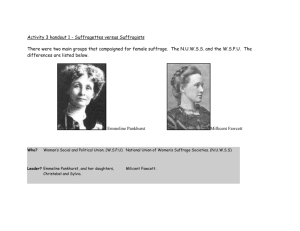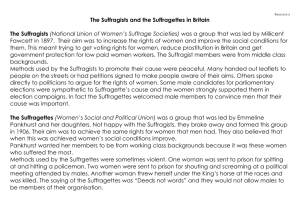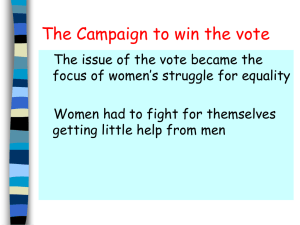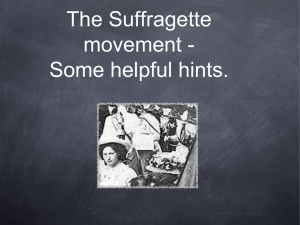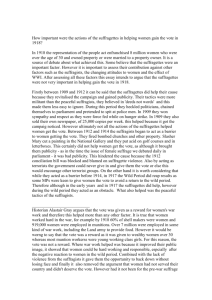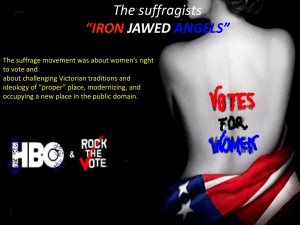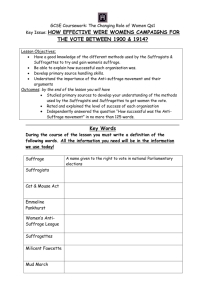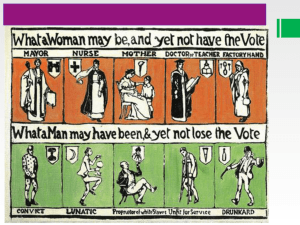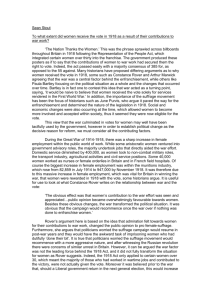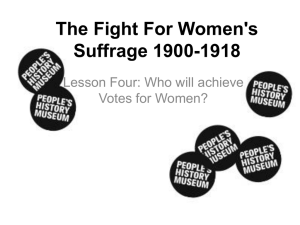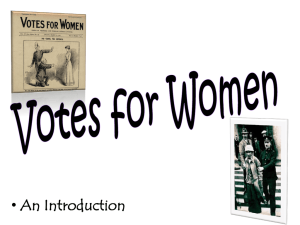Women`s suffrage
advertisement
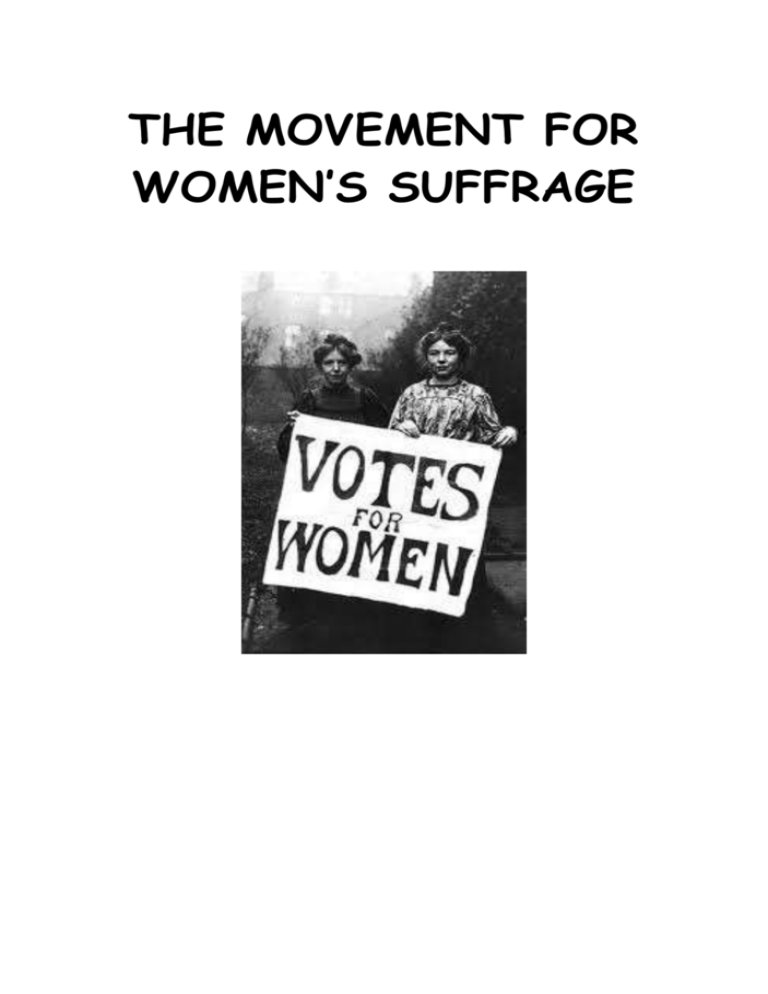
THE MOVEMENT FOR WOMEN’S SUFFRAGE COMMON QUESTIONS Why did it take so long for women to gain the vote? How important a role did the Suffragists play in winning women the vote? Did the Suffragettes’ militant campaign do more harm than good in the cause of votes for women? To what extent was women’s war effort the main reason for winning the vote in 1918? KEY FIGURES Emily Davies Millicent Fawcett John Stuart Mill Elizabeth Garret Anderson Sophia Jex-Blake Emmeline Pankhurst Herbert Asquith (Liberal Prime Minister) KEY EVENTS Married Women’s Property Act (1870) Matrimonial Causes Act (1873) Women’s Trade Union League formed (1874) NUWSS (Suffragists) formed (1887) Match Girls Strike (1889) WSPU (Suffragettes) formed by Emmeline Pankhurst Failure of Conciliation Bill leads to the ‘Wild Period’ (1912) Emily Davison Incident (1913) ‘Cat & Mouse’ Act (1913) Suspension of Militant Campaign (1914) Enfranchisement of Women (1918/28) BACKGROUND th In the 19 century, women were discriminated against in many areas of society They made up 1/3 of the work-force but worked in low-paid menial jobs in factories or domestic service Women were considered ‘too emotional’ and incapable of understanding the issues of the day Women were ignored in the reform acts of 1867 and 1884 leading to the rise of female suffrage groups World War1 provided women with new opportunities to prove their worth in society WHY DID IT TAKE SO LONG FOR WOMEN TO WIN THE VOTE? Politics was traditionally male – dominated; there was deep-rooted prejudice against women becoming involved Women were often poorly educated & had few opportunities to better themselves The achievements of the suffragists won sympathy but their methods were too moderate to force the issue on to the public agenda The militant campaign of the suffragists lost a great deal of public support for the campaign Many MP’s considered votes for women to be an unimportant issue; others like the Prime Minister Asquith were opposed to votes for women HOW IMPORTANT WAS WOMEN’S SUFFRAGE BEFORE 1903? Industrialisation saw a huge increase in the number of women in the workplace. At first, women were not allowed to belong to Trade Unions; suffrage groups were formed to campaign for better working conditions In 1874, the Women’s Trade Union League was formed. It campaigned successfully against sweated labour and low pay The Match Girls Strike was a landmark victory for the women’s movement In 1887, Millicent Fawcett brought together the various female suffrage groups under the banner of the NUWSS (Suffragists) The Suffragists always campaigned within the law. They held peaceful demonstrations, organised petitions and wrote letters to MPs Their leadership was largely intelligent, middle-class, well-connected women who were in a position to influence a growing number of sympathetic politicians. From 1888, many women were able to vote in local council elections The suffragists also campaigned successfully for changes in domestic law: the Matrimonial Causes Act and the Married Women’s Property Act gave women more control over their domestic circumstances Despite compulsory education from 1870, further education was still denied to most girls; some universities accepted female students but refused to award degrees Leading suffragists championed the right of women to enjoy further education: Emily Davis founded Girton College in 1874 while Elizabeth Garrett-Anderson (who took her medical degree in Paris) and Sophia Jex-Blake founded the London Medical School for Women The Suffragists won a great deal of admiration and helped to improve the status of women in society but were too moderate in their methods to force the issue of votes for women HOW SUCCESSFUL WAS THE MILTANT CAMPAIGN? The WSPU (Suffragettes) was formed in 1903 by Emmeline Pankhurst: they were disillusioned by the slow progress of the Suffragists They believed in ‘deeds not words’. They campaigned on the single issue of ‘votes for women’ The Liberal Government were divided over the issue of votes for women. Prime Minister Asquith opposed female suffrage. The Liberals increasingly became ‘the enemy’ of the Suffragettes Militancy increased in 1909 with damage to public property: hunger strikes began – this caused public anger Some members disapproved of militancy; others were unhappy with Mrs Pankhurst’s dictatorial leadership. This led to the formation of the Women’s Freedom League in 1907 In 1910, The Liberal Government was re-elected. Under pressure, Asquith agreed to a Conciliation Bill which would have given some women the vote if it became law The Bill failed to go through Parliament 3 times between 1910 – 1912. MP’s used ‘filibustering’ to delay the Bill’s passage. Irish MP’s refused to vote on the Bill considering it unimportant The failure of the Bill signaled the ‘Wild Period’. The ‘Cat & Mouse’ Act was passed due to the alarming increase in hunger strikes The suffragettes lost sympathy from the public and important politicians such as LloydGeorge and Churchill. The Media condemned their ‘irresponsible’ behaviour, such as the Emily Davison incident WHAT WAS THE IMPACT OF WORLD WAR 1? When war broke out, Mrs Pankhurst suspended the militant campaign and demanded the right for women to contribute to the war effort Women were required to fill the jobs in industry left vacant by military recruits; the government launched a huge recruitment campaign By 1918, around 4 million women were employed directly by the war effort. Around 800,000 Munitionettes who worked in highly dangerous conditions while about 250,000 worked in the Women’s Land Army. Women also worked in transport, engineering, construction, clerical work, public services (eg postal workers) and emergency services. In 1915, the Women’s Police Service was formed The Voluntary Aid Detachment (VAD) recruited volunteer nurses like Vera Brittain to serve behind the lines. Women also joined the military services – WRENS, WAAC and WRAF where they performed tasks such as telephonists, engineers, drivers, decoders etc Women proved their capabilities and won great admiration for their skill, determination and bravery. Even Asquith had to admit their crucial role In 1918, the Representation of the People Act gave propertied women over 30 the vote (this excluded many of those who had helped the war effort) Nancy Astor became the first female MP in 1919, but it was not until 1928 that the Equal Franchise Act was passed It is often argued that the war effort alone won women the vote but this is too simplistic an argument; the Bill to give women the vote was drafted in 1910 and may have been delayed by the war; many women who helped the war effort were excluded in 1918 CONCLUSION There were many formidable obstacles in the way of women receiving the vote Although they did not win the vote, the Suffragists were very important in improving the status of women in society The Suffragettes grabbed the headlines but militancy held back their cause World War 1 gave women new opportunities and was a significant factor in the enfranchisement of 1918: full equality, however, was not achieved until 1928 HISTORIOGRAPHY & SOME USEFUL QUOTES Many historians agree that the war was the most important factor in winning women the vote ‘war smoothed the way for democracy.’ AJP Taylor others argue women would have been given the vote without the war and that the female suffrage campaigns were more important Some historians believe that the Suffragists achieved more than the Suffragettes, whose militant campaign backfired [Women’s suffrage is] ‘a mad, wicked folly.’ Queen Victoria ‘The presence of a young woman in the operating theatre is an outrage.’ Middlesex Hospital ‘We are here not because we are law-breakers but because we wish to become law-makers.’ Emmeline Pankhurst ‘Their cause had marched backwards’. Churchill ‘How could we have carried on the war without women?’ Asquith
